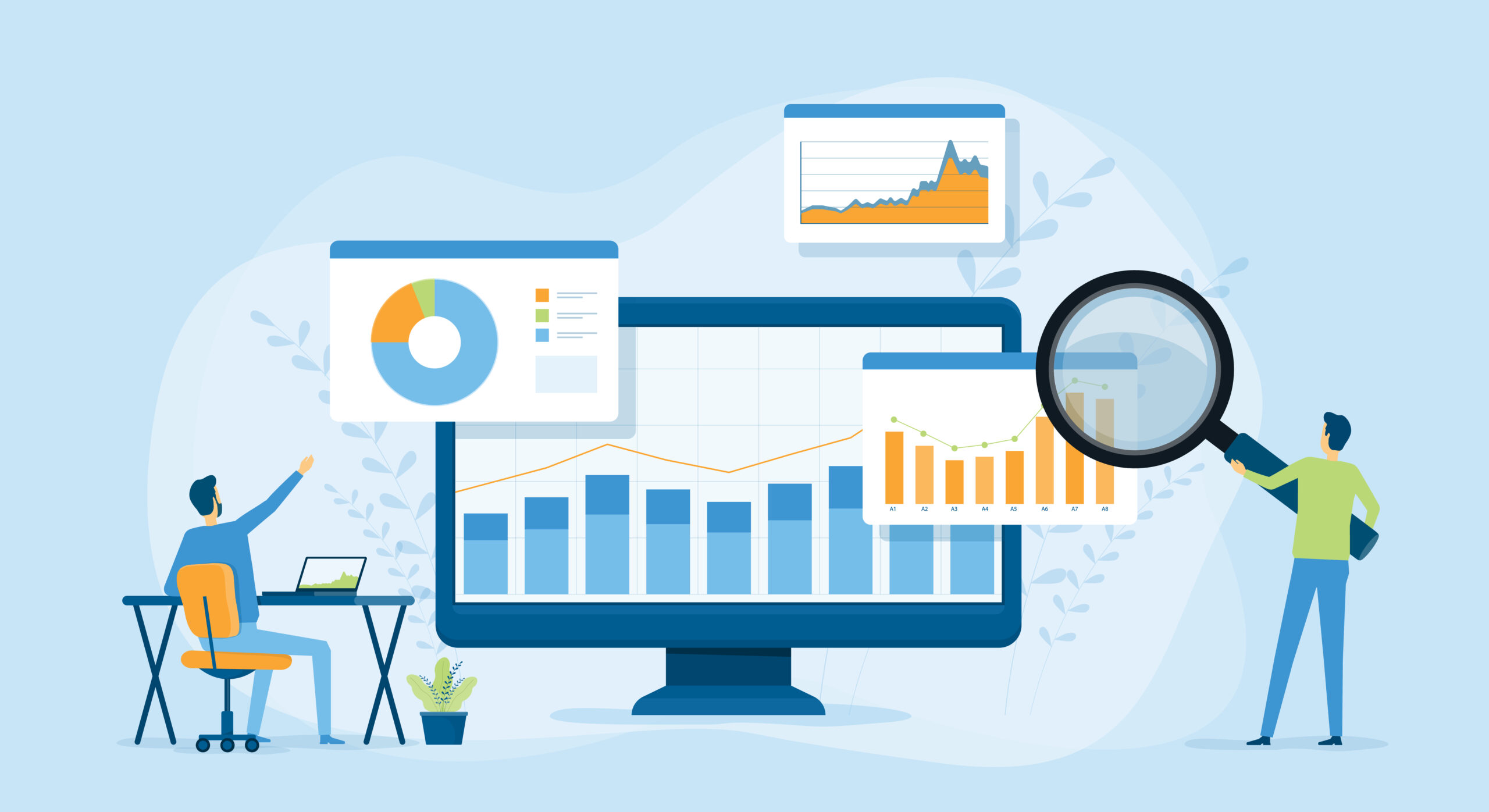Marketers need more than just a collection of numbers – they need actionable insights. A Marketing KPI Dashboard is a crucial tool that not only tracks performance but also helps you understand trends, measure success, and make strategic, data-driven decisions.
Many marketing teams struggle with creating a dashboard that goes beyond surface level metrics. In this article, we will walk you through five simple steps to build a powerful marketing analytics dashboard that provides deep insights into your campaigns and overall marketing performance.
Step 1: Define Your Key Marketing Metrics
Before you can build an effective marketing KPI dashboard, it’s essential to define which metrics are most critical for your business.
Marketing KPIs (Key Performance Indicators) should align with your overall business goals, ensuring that every metric you track provides value and insight into your operations. Don’t pick too many! For most businesses, tracking 5 to 6 KPIs is typically sufficient to provide clear actionable insights.
Understanding the Importance of KPIs
KPIs help you monitor whether your strategies are working and alert you when adjustments are needed. By clearly defining your KPIs, you can focus on what matters most and avoid getting lost in an overload of data. For example, if your primary goal is to drive revenue, then metrics like Customer Acquisition Cost (CAC) and Return on Ad Spend (ROAS) become essential.
Essential Marketing KPIs to Track on Your Dashboard
Consider categorizing your marketing KPIs into different buckets based on your marketing objectives:
-
- Traffic Metrics: These include website visits, page views, and bounce rates. Tracking these metrics helps you understand how many people are interacting with your site and whether your content is engaging enough to keep them around.
-
- Lead Generation Metrics: Here, conversion rate, cost per lead (CPL), and lead to customer ratio are key. These indicators show you how effective your lead generation efforts are and the efficiency of your funnel.
-
- Revenue Metrics: Metrics such as Customer Acquisition Cost (CAC), Return on Ad Spend (ROAS), and Customer Lifetime Value (LTV) are crucial if revenue is your primary target. They help you understand how much you’re spending to acquire a customer and how profitable they are over time.
-
- Engagement Metrics: Measuring email open rates, click through rates, and social media engagement allows you to gauge how well your content resonates with your audience.
Pro Tip:
Use tools like SegMetrics to track lead attribution. This not only helps you identify the most valuable customers but also reveals which marketing channels are delivering the best return on investment.
By clearly outlining your KPIs, you create a solid foundation for your dashboard that ensures all subsequent steps align with your marketing goals.
Once you’ve defined your metrics, the next step is selecting a dashboard tool that fits your needs. The right software can simplify data collection and visualization, making it easier to draw actionable insights.
There are several tools available in the market, each with its own strengths and weaknesses. When choosing a tool, consider the following:
-
- Integrations: The tool should easily integrate with your existing CRM and marketing platforms. This reduces the need for manual data entry and minimizes errors.
-
- User Interface: An intuitive and user-friendly interface is crucial. The best tools allow you to customize dashboards so that you can focus on the metrics that matter most.
-
- Scalability: As your marketing efforts expand, your tool should be able to handle an increase in data and complexity without compromising on performance.
-
- Real-Time Data: For many marketers, having daily data is crucial. Choose a tool that offers person-based analytics to keep your team on the cutting edge.
Here are some of the most popular and effective tools available:
-
- SegMetrics: Ideal for advanced revenue attribution and customer lifetime value tracking. It’s particularly useful for businesses that want to connect every marketing activity to revenue generation and it’s unmatched at middle of funnel tracking. Connects with over 100 integrations.
-
- Google Analytics 4: A free tool that provides robust tracking for web traffic and engagement, making it a great starting point for many businesses.
-
- HubSpot: HubSpot unifies your marketing, sales, and service efforts to deliver comprehensive CRM-based analytics but does not integrate with any external applications or integrations.
-
- Google Looker Studio: A flexible tool that allows for extensive customization, making it easier to create dashboards that are tailored to your needs.
-
- Tableau: Best suited for enterprise-level analytics, Tableau offers powerful data visualization and business intelligence reporting.
Pro Tip:
Select a tool that integrates seamlessly with your current systems. This will help avoid the pitfalls of manual data reconciliation and streamline your reporting process.
Step 3: Connect Your Data Sources
The value of your dashboard is directly related to the quality and comprehensiveness of the data it aggregates. Connecting all relevant data sources ensures that your dashboard paints a complete picture of your marketing performance.
Identify Your Data Sources
Begin by
identifying the platforms and systems where your marketing data resides. These typically include:
-
- Website Analytics: Tools like Google Analytics track visitor behavior, website performance, and overall engagement.
-
- Email Marketing Platforms: Services such as ActiveCampaign or Mailchimp track email engagement, conversion rates, and overall campaign performance.
-
- Advertising Platforms: Google Ads, Facebook Ads, and other similar platforms provide data on campaign performance, including metrics like ROAS and cost per click.
-
- CRM Systems: Systems like HubSpot, HighLevel, or Keap are invaluable for tracking leads, managing customer relationships, and understanding revenue attribution.
Integrating Data Seamlessly Into Your Marketing KPI Dashboard
Integration is a key challenge when connecting multiple data sources. Many modern dashboard tools offer built-in integrations or APIs to facilitate this process. If you are using a tool like SegMetrics, the integration process can be more streamlined, as it allows you to unify lead tracking data from various platforms. This unified approach ensures that you have a consistent and reliable dataset for your analyses.
Pro Tip:
Invest time in configuring your integrations correctly. Consistent data feeds mean your dashboard will always have up-to-date information, allowing you to make informed decisions quickly. If you join SegMetrics, our team can support you in getting fully set up and connected.
Step 4: Design a Clear and Actionable KPI Dashboard Layout
A
beautifully designed dashboard is more than just an attractive interface – it’s a powerful communication tool. A well-thought-out layout makes it easy for team members to quickly interpret data and take action.
Principles of Effective Dashboard Design
-
-
- Simplicity is Key:
Focus on displaying only the most critical KPIs. A cluttered dashboard can overwhelm users and obscure important trends.
-
- Data Visualization:
Use graphs, charts, and heatmaps to turn raw data into easily digestible insights. Visualization helps to identify trends and outliers that may not be immediately apparent in a spreadsheet.
-
- Segmentation:
Break down data by traffic source, campaign, or customer segment. This granularity can provide more targeted insights into what is working and what isn’t.
-
- Goal Setting and Benchmarking:
Compare your current performance against historical data or set benchmarks. This context helps you gauge progress and identify areas that need improvement.
-
- Real-Time Updates:
A dynamic dashboard that updates in real time ensures that your team always has access to the latest data. This is especially important in fast-moving markets where conditions can change quickly.
Best Practices for a Marketing KPI Dashboard Layout
-
- Hierarchy of Information:
Organize your dashboard so that the most important metrics are front and center. Less critical data can be tucked away in secondary sections.
-
- Interactive Elements:
If possible, include interactive elements such as filters or drill-down capabilities. This allows users to explore the data more deeply without overwhelming the initial view.
-
- Consistency:
Use consistent color schemes, fonts, and styles across your dashboard. A consistent design reduces cognitive load and helps users focus on the insights rather than the design.
Pro Tip:
Consider designing your dashboard layout on paper or using wireframing tools before implementation. This preliminary step can help you visualize the final product and ensure that all key elements are included. The SegMetrics team can
create a dashboard for you!
Step 5: Analyze, Optimize, and Take Action
A marketing dashboard is not a static display of numbers – it is a tool for continuous improvement. Regular analysis of your data will reveal trends, highlight successes, and expose areas in need of improvement.
Making Data-Driven Decisions
The true power of a KPI dashboard lies in its ability to drive action. Here’s how to leverage your dashboard for maximum impact:
-
- Identify High-Performing Channels:
Use your dashboard to pinpoint the marketing channels that are delivering the best results. Once identified, allocate more resources to these channels to maximize return on investment.
-
- Spotting Drop-Off Points:
Analyze the customer journey to identify where potential customers are abandoning the funnel. Addressing these drop-off points can significantly improve conversion rates.
-
- A/B Testing and Iteration:
Use the insights from your dashboard to test different strategies. For instance, if a particular campaign is underperforming, consider A/B testing new headlines, images, or calls-to-action until you find a more effective approach.
-
- Regular Reporting and Communication:
A dashboard should serve as a central hub for team alignment. Share insights regularly during marketing meetings, and use the data to inform strategy sessions and performance reviews.
Continuous Improvement
Remember that the digital marketing landscape is constantly evolving. Regularly revisit and refine your KPIs to ensure they remain aligned with your business goals. As new marketing channels and technologies emerge, your dashboard should adapt to incorporate these changes.
Pro Tip:
Use SegMetrics to continuously monitor customer lifetime value and revenue attribution.
Understanding the direct impact of each marketing channel on your bottom line can help justify budget allocations and strategic shifts.
Final Thoughts
Building a powerful marketing KPI dashboard doesn’t have to be an overwhelming task. By following these five simple steps – defining key metrics, choosing the right tools, connecting your data sources, designing a clear layout, and continuously analyzing and optimizing – you create a dynamic tool that not only tracks your performance but also drives strategic action.
A well-designed dashboard transforms raw data into clear insights, helping you stay ahead of the competition. Whether you’re a seasoned marketer or just starting out, investing time and resources into building an effective dashboard is essential for long-term success.
Remember, the ultimate goal is not just to collect data but to use that data to fuel smarter decision-making and more effective marketing campaigns. With the right approach and tools in place, your dashboard can become the cornerstone of your marketing strategy, offering real-time insights that lead to better customer engagement and increased revenue.
🚀 Ready to track your marketing performance with actionable, revenue-focused insights? Consider implementing tools like
SegMetrics to see how your efforts translate from first click to final sale, and empower your team to make data-driven decisions every day.
By following this comprehensive guide, you’re not only setting up a dashboard – you’re laying the foundation for a culture of continuous improvement and success in your marketing efforts. Whether you’re scaling up your operations or fine-tuning your existing strategies, a powerful marketing KPI dashboard is the tool you need to unlock the full potential of your data.






